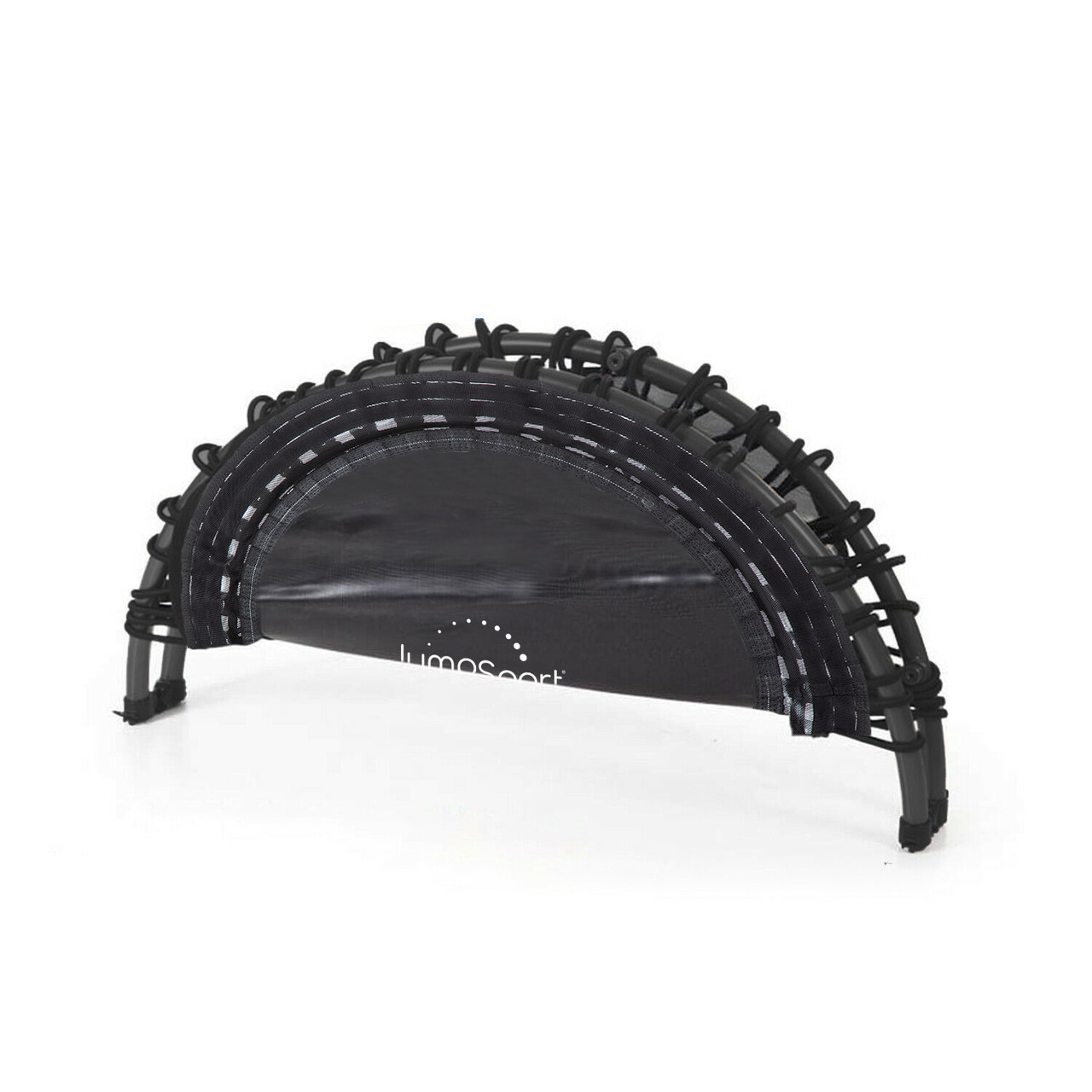

Benefits of Rebounding
Rebounding is a simple yet effective low-impact exercise that involves bouncing on a mini-trampoline and is perfect for all fitness levels, ages, and works with almost any modality.
These benefits of rebounding will make you want to jump up and start re-thinking the way you work out!
Top Benefits Of Rebounding
- Cardio: Stronger Heart
- Weight Loss: Efficient Calorie Burn
- Balance: Heightened Proprioception
- Mental Health: Stress Relief
- Wellness: Increased Lymphatic Flow
- Recovery: Fast Muscle Recuperation
- Fun Factor: Bouncing Brings Joy!
Rebounding Is Good For...
Cardio & Weight Loss
Rebounding is a low impact, total body workout that enhances your cardiovascular health and aids in weight loss. It boosts metabolism, burns calories, and strengthens the heart muscle.

Key cardiovascular and weight loss benefits:
- Boosts Metabolism: Rebounding supercharges your metabolism, helping you burn calories even after your workout.
- Strengthens the Heart: Regular rebounding fortifies the heart and other muscles in the body, promoting overall cardiovascular health.
- Lowers Cholesterol: Rebounding can effectively lower circulating cholesterol and triglyceride levels, contributing to a healthier lipid profile.
- Improves Circulation: The exercise enhances blood circulation, which can contribute to better oxygen supply throughout the body.
- Prevents chronic edema/swelling: Bouncing decreases the volume of blood pooling in the veins of the cardiovascular system
- Manages Body Composition: Rebounding helps manage body composition and improves muscle-to-fat ratio, aiding in weight management.
- Improves Endurance: Rebounding increases respiration and capacity for breathing, which can lead to improved lung health and endurance.
- Reduces Appearance of Cellulite: constant muscle engagement helps tone and strengthen the muscles beneath the skin, leading to improved muscle tone and firmness.
- Enhances Digestion and Elimination Processes: Rhythmic bouncing movements stimulate the muscles of the digestive tract, promoting peristalsis—the wave-like contractions that move food through the digestive system and prevent constipation.
- Reduces Blood Pressure: Rebounding lessens the time during which blood pressure remains abnormal after severe activity
- Increases G-force: The repetitive impact of rebounding can strengthen bones by increasing bone density, particularly in the lower body, and reduce the risk of osteoporosis and bone fractures.
- Aids alkaline reserve of the body: Maintaining a sufficient alkaline reserve, the body can better withstand the metabolic demands and environmental stressors which may be of significance in an emergency requiring prolonged effort
Balance & Mental Health
Rebounding can have several positive effects on mental health, thanks to its unique combination of physical activity, stress reduction, and enjoyment. Furthermore, it enhances proprioception and equilibrium, which are essential for maintaining and improving balance and coordination.

Key balance and mental well-being benefits:
- Improves Coordination: Rebounding improves coordination between the proprioceptors in the joints, enhancing balance and motor skills.
- Boosts Mental Performance: Rebounding can lead to better mental performance with keener learning processes, sharpening your cognitive abilities, & improved memory.
- Reduces Anxiety: Rebounding can reduce feelings of anxiety and depression by increasing endorphins, the body’s natural mood boosters.
- Stimulates the Vestibular System: Rebounding stimulates the vestibular system, which controls balance, contributing to improved stability and coordination.
- Enhances Self-Image: Rebounding is an effective form of exercise by which the user gains a sense of control and an improved self-image, and has fun while doing it.
- Improves Cognitive Function: Rebounding can help increase blood flow to the brain, delivering oxygen and nutrients that support optimal cognitive performance.
Wellness & Recovery
Rebounding plays a significant role in overall wellness, most notably how it improves lymphatic flow. Additionally, it allows the body to recover faster due to the low-impactive nature of the exercise.

Key wellness and recovery benefits:
- Increases Lymphatic Drainage: Rebounding stimulates the millions of one-way valves in the lymphatic system, naturally helping flush out excess fluids and toxins.
- Promotes Tissue Repair: Rebounding promotes tissue repair and protects the joints from the chronic fatigue and impact delivered by exercising on hard surfaces.
- Improves Sleep: Rebounding allows for deeper sleep and easier relaxation, contributing to overall wellness.
- Keeps You Young: Rebounding slows down atrophy in the aging process, helping you stay young and vibrant.
- Relieves Pain: Rebounding can relieve pain from sore neck and back, headaches, and discomfort caused by lack of exercise. It’s easier on joints than the impact of running.
- Increases Energy Levels: combat feelings of fatigue and lethargy through the combination of cardiovascular activity and oxygen circulation to help you feel more energized and alert.
- Naturally Boosts Immune System: Rebounding can help minimize the number of colds, allergies, digestive disturbances, and abdominal problems
Recommended Products


FAQ’s About Rebounding
How many minutes a day should you rebound?
Most fitness professionals recommend that you rebound at least 10 mins per day. For a more effective workout, gradually increase your bounce time up to 60 mins. Be sure to take breaks and stay hydrated.
Does bouncing reduce belly fat?
Rebounding can contribute to overall fat loss, including belly fat, when combined with a healthy diet and regular exercise routine. For optimal results, combine your favorite trampoline workout with other forms of exercise, such as strength training and cardiovascular workouts.
How long should you rebound for lymphatic drainage?
The ideal duration and frequency of rebounding for lymphatic drainage may vary from person to person. It's essential to listen to your body, start gradually, and adjust your routine based on how you feel. In her 2008 book, Rebounding To Better Health, Linda Brooks states that even 5-10 minutes a day can jumpstart lymphatic flow by 15-30x!
If you have any underlying health conditions or concerns, consult with a healthcare professional before beginning a new exercise program, including rebounding.
Is rebounding better than walking?
Ultimately, the best exercise is one that you enjoy and can consistently incorporate into your lifestyle. Both rebounding and walking offer numerous health benefits and can be valuable components of a well-rounded fitness program. Consider your personal preferences, fitness goals, and any physical limitations when choosing between the two activities, and don't hesitate to mix and match based on your needs and interests.
Can You overdo it with rebounding?
Like any form of exercise, it is possible to overdo it with rebounding. While there are many benefits of rebounding, excessive or improper use can lead to various issues, including fatigue, muscle soreness, joint strain, and overuse injuries.

ACE-SPONSORED RESEARCH
Putting Mini-trampolines to the Test
“After learning common movements and getting comfortable on the mini-trampoline, the participants completed a monitored trampoline exercise session while following a routine designed by JumpSport (www.jumpsport.com). The 19-minute JumpSport exercise video featured motivational music and incorporated a variety of choreography and movements to create a full-body workout. Heart rates and VO2max were collected every minute and caloric expenditure was calculated from the VO2 data. RPE was also assessed every five minutes.”
18 Studies About The Benefits of Rebounding
- Aalizadeh B, Mohammadzadeh H, Khazani A, Dadras A. Effect of a Trampoline Exercise on the Anthropometric Measures and Motor Performance of Adolescent Students. Int J Prev Med. 2016 Jul 13;7:91. doi: 10.4103/2008-7802.186225. PMID: 27512557; PMCID: PMC4966200.
https://pubmed.ncbi.nlm.nih.gov/27512557/ - Beerse, M., Wu, J. Spring-like leg dynamics and neuromuscular strategies for hopping on a mini-trampoline in adults and children. Exp Brain Res 238, 2087–2096 (2020). https://doi.org/10.1007/s00221-020-05873-0
- Bereza, D.; Sokołowska, K.; Kulak, M.; Moreau, I.; Polańska, P.; Lang, M.; Woch, B. Springing to Life: Unveiling the Transformative Effects of Trampoline Bouncing on Human Health. J Educ Health Sport 2024, 54, 200-214.
https://apcz.umk.pl/JEHS/article/view/47853 - Bhattacharya A, McCutcheon EP, Shvartz E, Greenleaf JE. Body acceleration distribution and O2 uptake in humans during running and jumping. J Appl Physiol Respir Environ Exerc Physiol. 1980 Nov;49(5):881-7. doi: 10.1152/jappl.1980.49.5.881. PMID: 7429911. https://pubmed.ncbi.nlm.nih.gov/7429911/
- Burandt P, Porcar JP, Cress ML, Doberstein S, Foster C, Green DJ. ACE-SPONSORED RESEARCH: Putting Mini-trampolines to the Test. PROSOURCE™. 2016 Oct.
https://www.acefitness.org/continuing-education/prosource/october-2016/6081/ace-sponsored-research-putting-mini-trampolines-to-the-test/ - Burt LA, Schipilow JD, Boyd SK. Competitive trampolining influences trabecular bone structure, bone size, and bone strength. J Sport Health Sci. 2016 Dec;5(4):469-475. doi: 10.1016/j.jshs.2015.01.007. Epub 2015 Apr 30. PMID: 30356528; PMCID: PMC6188882.
https://pubmed.ncbi.nlm.nih.gov/30356528/ - Cogoli A. Changes observed in lymphocyte behavior during gravitational unloading. ASGSB Bull. 1991 Jul;4(2):107-15. PMID: 11537173.
https://pubmed.ncbi.nlm.nih.gov/11537173/ - Cogoli A, Valluchi M, Reck J, Müller M, Briegleb W, Cordt I, Michel C. Human lymphocyte activation is depressed at low-g and enhanced at high-g. Physiologist. 1979 Dec;22(6):S29-30. PMID: 545374.
https://pubmed.ncbi.nlm.nih.gov/545374/ - de Oliveira MR, da Silva RA, Dascal JB, Teixeira DC. Effect of different types of exercise on postural balance in elderly women: a randomized controlled trial. Archives of Gerontology and Geriatrics. 2014 Nov-Dec;59(3):506-514. DOI: 10.1016/j.archger.2014.08.009. PMID: 25239512.
https://europepmc.org/article/med/25239512 - Edin, J.B. et al. (1990). Analysis of the training effects of minitrampoline rebounding on physical fitness, body composition, and blood lipids. Journal of Cardiopulmonary Rehabilitation, 10, 401–408.
https://journals.lww.com/jcrjournal/abstract/1990/11000/analysis_of_the_training_effects_of_minitrampoline.2.aspx - Esposito PW, Esposito LM. The reemergence of the trampoline as a recreational activity and competitive sport. Curr Sports Med Rep. 2009 Sep-Oct;8(5):273-7. doi: 10.1249/JSR.0b013e3181b8f60a. PMID: 19741356.
https://pubmed.ncbi.nlm.nih.gov/19741356/ - Gerberich, Susan Goodwin PhD*; Leon, Arthur S. MD, FACSM†; McNally, Carl BS‡; Serfass, Robert PhD, FACSM§; Edin, Joan Bartlett MPH∥. Analysis of the Acute Physiologic Effects of Minitrampoline Rebounding Exercise. Journal of Cardiopulmonary Rehabilitation 10(11):p 395-400, November 1990.
https://journals.lww.com/jcrjournal/Abstract/1990/11000/Analysis_of_the_Acute_Physiologic_Effects_of.1.aspx - McGlone, Colleen B.S.; Kravitz, Len Ph.D.; Janot, Jeffrey M. Ph.D.. Rebounding: A Low-Impact Exercise Alternative. ACSM'S Health & Fitness Journal 6(2):p 11-15, March 2002.
https://journals.lww.com/acsm-healthfitness/Citation/2002/06020/Rebounding__A_Low_Impact_Exercise_Alternative.6.aspx - Okemuo AJ, Gallagher D, Dairo YM. Effects of rebound exercises on balance and mobility of people with neurological disorders: A systematic review. PLoS One. 2023 Oct 5;18(10):e0292312. doi: 10.1371/journal.pone.0292312. PMID: 37797042; PMCID: PMC10553300.
https://pubmed.ncbi.nlm.nih.gov/37797042/ - Schöffl, I., Ehrlich, B., Rottermann, K. et al. Jumping into a Healthier Future: Trampolining for Increasing Physical Activity in Children. Sports Med - Open 7, 53 (2021). https://doi.org/10.1186/s40798-021-00335-5
- Stanghelle JK, Hjeltnes N, Bangstad HJ, Michalsen H. Effect of daily short bouts of trampoline exercise during 8 weeks on the pulmonary function and the maximal oxygen uptake of children with cystic fibrosis. Int J Sports Med. 1988 Feb;9 Suppl 1:32-6. doi: 10.1055/s-2007-1025059. PMID: 3360541.
https://pubmed.ncbi.nlm.nih.gov/3360541/ - Sukkeaw W, Kritpet T, Bunyaratavej N. A Comparison between the Effects of Aerobic Dance Training on Mini-Trampoline and Hard Wooden Surface on Bone Resorption, Health-Related Physical Fitness, Balance, and Foot Plantar Pressure in Thai Working Women. J Med Assoc Thai. 2015 Sep;98 Suppl 8:S58-64. PMID: 26529816.
https://pubmed.ncbi.nlm.nih.gov/26529816/ - Witassek C, Nitzsche N, Schulz H. The effect of several weeks of training with minitrampolines on jump performance, trunk strength and endurance performance. Dtsch Z Sportmed. 2018; 69: 38-44. doi:10.5960/dzsm.2018.318
https://www.germanjournalsportsmedicine.com/archive/archive-2018/heft-2/the-effect-of-several-weeks-of-training-with-mini-trampolines-on-jump-performance-trunk-strength-and-endurance-performance/






